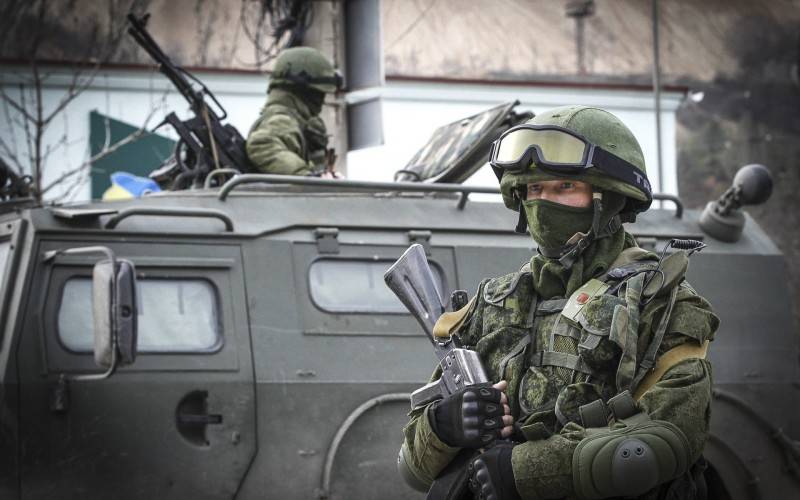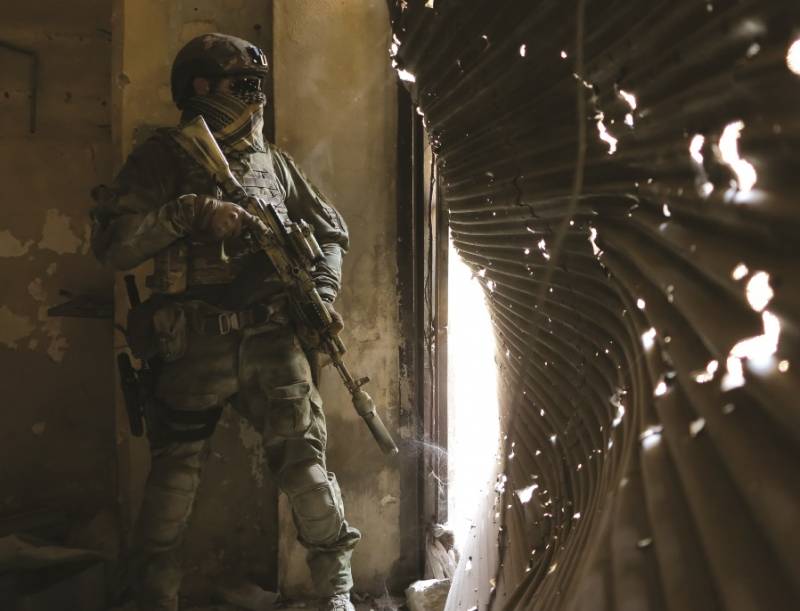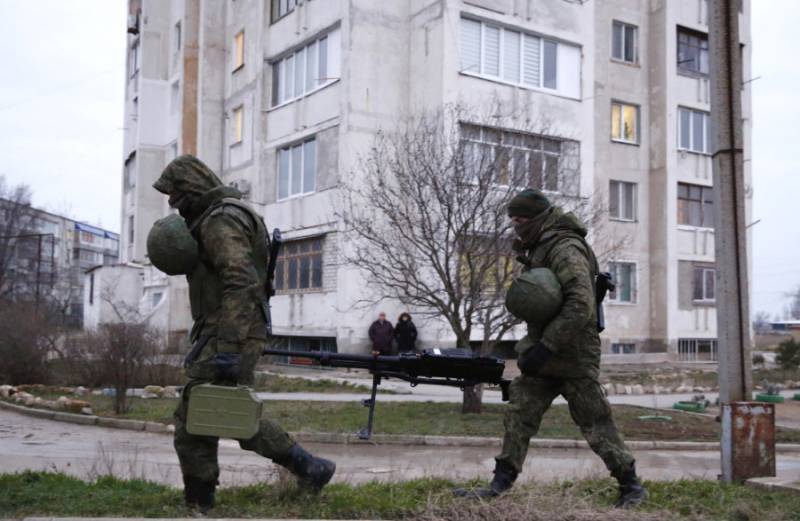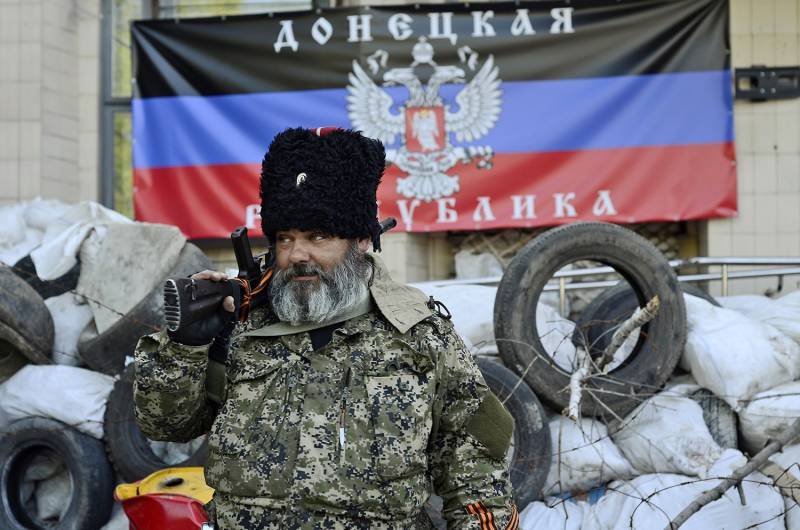Western look at Russian special forces in the Crimea and the Donbas

Annotation: The special forces played an important role in the course of Russian military actions against Ukraine. If in Crimea they were mainly involved in clandestine operations, in the Donbas they performed more traditional functions, such as special intelligence, military assistance, and direct actions. The annexation of the Crimea was the first time that the new special forces acted in a leading role. On the basis of the Ukrainian experience, one can undoubtedly speak of Russia's increased capabilities in the field of special operations. This fact, in turn, may have implications for contingency planning in other countries, including the United States.
This article explores the question of the role of special forces during the hostilities of Russia against Ukraine - in the Crimea and the Donbas. The first part provides a brief overview of the various types of Russian special operations forces and how these forces fit into the concept of a “hybrid” war. Further, special operations of Russia in the Crimea and the Donbas are analyzed in the context of standard categories of tasks performed by special forces. The final part discusses the issue of lessons that other countries, including the United States, can learn from the examples of Crimea and Donbass.
First of all, it is necessary to briefly address the question of sources. Given the special nature of special operations, the search for reliable information is difficult. In this situation, it manifests itself even more due to the recent nature of the events and the fearfulness of the Russian press. With the exception of a few media outlets and Internet resources, representatives of investigative journalism in modern Russia are forced to remain silent. In addition to the officially confirmed use of special forces in the Crimea and the arrest of two officers of the GRU special forces in Donbas in May 2015, the information in Russian open sources is poorly presented.
Consequently, this work is largely based on Ukrainian sources. Since Ukraine is one of the parties to the conflict, these sources are obviously biased. The used Ukrainian sources can be considered relatively independent of the government of the country. However, they are not objective. Most of them, for obvious reasons, reflect the varying degrees of patriotism shown in the face of Russian military aggression.
On the other hand, taking into account the fact that the presence of Russian troops on the territory of Ukraine clearly took place, there is little reason to believe that special forces are not there either. No modern army would not be involved in a foreign operation of a similar scale without setting targets for its own special units. Therefore, the possible distortions in the analysis in connection with the use of Ukrainian sources will most likely relate to the details of the actions of special forces, and not to the very fact of its presence.
Russian special forces in the period of reforms Serdyukov
There are many military and paramilitary units in Russia, called special forces or special forces. For this study, the most relevant are the special forces of the Main Intelligence Directorate, the Federal Security Service, the Foreign Intelligence Service, the Special Operations Forces (MTR) and the 45-I separate special forces of the Airborne Forces. It should be understood that special forces are only part of each of these organizations. The structure of the GRU, the FSB and the SVR are various units, such as the intelligence service ("agents"), radio intelligence and others. These units are also included in the study, as in their work they often interact with special forces. However, being in one structure does not always guarantee close cooperation. The rivalry between special forces and the agents of the GRU is well known.
The GRU spetsnaz is probably the most famous special forces unit in Russia. This organization was founded in 1950 and played an important role during the Russian military operations in Afghanistan and Chechnya. Accordingly, the unit has experience of participating in operations as an elite group of light infantry rather than special forces in the current Western sense of the term. Thus, the GRU special forces today would be more appropriate to compare with the US Army Rangers, and not with the Delta special forces. This auxiliary role was to some extent formalized during the reform period of Minister Serdyukov. The duties of the GRU special forces in providing services to other military structures were expanded to the detriment of the more independent position that it had previously.
In parallel, new Special Operations Forces (MTR) were formed as a military instrument under the direct control of the country's political leadership. The spetsnaz of the GRU consists of seven brigades distributed throughout the country, each consisting of about 1,500 people - combat and auxiliary units combined. In addition, there are four naval units, one for each of the fleets. They are likely to have about 500 troops in each. [1] Thus, the total number of troops is approximately 12,000 people. GRU spetsnaz was planned to be transferred to a contract basis until the end of 2014. However, today it is difficult to find confirmation of the fact of achieving this goal. The conscripts played an important role in the GRU special forces.
Special Operations Forces of Russia in Syria
The creation of the SSO was announced by the Chief of the General Staff, General Valery Gerasimov in March 2013, but the idea itself was under development since 2009. It was based on the US DeltaForce (US DeltaForce) model and the British Special Air Service (SpecialAirService) model. The organization is divided into five special operations divisions (special operations or divisions) of 50 military personnel each, and a total number (including auxiliary units) of the order of 1,500 people. The establishment of the MTR has become a symbol of the loss of the GRU of its institutional status. The new special forces were originally part of the GRU, then were withdrawn from its composition, and now they are again officially in the structure of the GRU, but they have much greater autonomy. In addition, the replenishment of personnel is carried out from outside the GRU. The key strategic idea of the MTR is that the political leadership of the country has a small and highly competent military instrument for use inside and outside the state in emergency situations that do not require large-scale military operations.
The structure of the FSB has two special purpose units - Alpha and Vympel. “Alpha” consists of five departments in different regions of Russia, and the main task of the unit is to conduct counter-terrorism operations. Vympel consists of four divisions and protects strategic facilities such as nuclear power plants. These special functions, however, in no way mean that the above-mentioned special forces cannot be used to perform other tasks. The total number of "Alpha" and "Vympel" is probably from 300 to 500 people.
The 45-I separate special-purpose brigade of the Airborne Forces as a whole performs the same functions as the GRU special forces in the structure of the ground forces, and the GRU special forces in the structure of the marines. Its number is about 700 people.
Finally, the SVR also has its own special forces numbering about 300 people called Barrier. Its main task is to protect Russian civil servants around the world, but other applications are possible.
Special forces and "hybrid" war
There are a considerable number of definitions of the term “hybrid” war, but there are also those who reject this concept. With regard to the Russian aggression against Ukraine, much attention was paid to non-military means of achieving strategic goals. It is important, as some researchers note, to keep in mind that the term “hybrid” refers to methods, but not to the principles or goals of warfare. Special forces by definition imply the use of military methods. The use of special forces in regular combat, therefore, does not fall under most definitions of a “hybrid” war. As a possible counter-argument, it should be noted that the use of special forces to achieve political goals in non-combat situations fits into the concept of a “hybrid” war.
According to the NATO classification, special operations can be divided into three main types: direct actions (directaction), special intelligence (specialreconnaissance) and military assistance. However, this classification does not cover some secret "political" tasks that special forces sometimes perform. Due to the fact that this type of tasks is of particular importance in the context of this work, I supplemented the concept of NATO with an item on hidden actions (covertaction). It is the implementation of hidden actions that makes the Russian special forces an instrument of a “hybrid” war. Next, we consider the participation of Russian special forces in regular operations in the Crimea and in the Donbas, as well as its role in non-combat actions with a view to influencing the local political situation.
Crimea
The Crimean operation, despite the fact that it was carried out, most likely, in accordance with the action plan in special situations, was unexpected and took place with almost no direct clashes. This means that the Russian special forces did not carry out direct actions, and they also did not have the time or need for military assistance. The operation consisted mainly of covert actions, most likely based on information collected previously by intelligence units related to the Black Sea the fleet Russian Navy and local agents of the FSB and GRU. Perhaps there was a preliminary deployment of GRU special intelligence units, but this information is difficult to confirm using open sources. Ukrainian military observer Dmitry Tymchuk claims that the FSB and the GRU began to show particular activity in Ukraine after Viktor Yanukovych assumed office in 2010. He changed the focus of the Security Service of Ukraine (SBU) from counterintelligence against Russia to counterintelligence against the United States. It would also be wrong to assert that the Russian special forces played a significant role in providing military assistance in Crimea, since the “Crimean Self-Defense Forces” apparently performed a decorative function and served as a cover for Russian troops. Self-defense forces did not have important military significance.
Near the Ukrainian military base in Yevpatoria, 9 March 2014. ”
Given that the actions of the special forces for the most part are secretive, one could understand that the newly created SSOs would play an important role. According to military observers Anton Lavrov and Alexei Nikolsky, the capture of the Crimea was the first major operation carried out by the MTR. In particular, the special operations forces were behind the seizure of the local 27 parliament in February. This allowed the Russian puppet of Sergei Aksenov to be elected chairman of the Council of Ministers of the Autonomous Republic of Crimea. Moreover, the SSO led the capture of important military facilities of the Armed Forces of Ukraine. However, these actions required a larger number of personnel than the available MTR. Therefore, special forces of the GRU and the Marines joined the special operations forces. However, it was the SSO that always stood at the head of operations.
In the Crimean operation, speed and surprise were used to create a faitaccompli situation (a fait accompli) in order to make Ukraine’s military response difficult. Indeed, the victory of Russia was secured by the transfer of additional forces, but the initial actions of the SSO and other "special" and "elite" forces played a decisive role. From the seizure of the Crimean parliament to the signing of the agreement on the inclusion of the Crimea in Russia, it took only 19 days. Seven days later, all units of the Supreme Soviet of Ukraine laid down weapon. Such periods seriously distinguish the Crimean operation from the subsequent fighting in the Donbas.
Donbass
Based mainly on the “selfie” of Russian soldiers on the Internet, a group of Ukrainian volunteers “InformNapalm” found out the names of servicemen from various units of the SSO who were on the territory of Ukraine. They include all seven brigades of the GRU special forces, the 45-I separate separate brigade of special-purpose airborne troops, as well as FSB officers. However, none of the open sources claimed that the SSO took part in these operations. According to Russian military observer Alexei Nikolsky, “given our knowledge of the SSO and their tasks, their presence in eastern Ukraine is not necessary. That is, the browser did not find any evidence of the presence of SSO in the Donbas. Their possible absence there fits into the idea of the MTR as an exclusive tool, used only where escalation of hostilities is unlikely. It also emphasizes that the Special Operations Forces with their high capabilities and “cost” of use are used only where no one else can solve the task.
The first officer of the GRU was detained on the territory of Ukraine by the Security Service of Ukraine in March 2014. He was detained together by three others during intelligence gathering about the positions of the Ukrainian armed forces on the Chongar peninsula north of the Crimea. His name was Roman Filatov and he confessed that he was an officer of the GRU. As a result of personal agreements between Russian Defense Minister Sergei Shoigu and the head of the presidential administration of Ukraine Sergey Pashinsky, Filatov was exchanged for the Ukrainian rear-admiral Sergey Haiduk and eight other persons detained by the new authorities of Crimea.
In addition to the GRU special forces, the Russian forgotten regiment website stated that the special purpose 45 regiment was seen in the Ukrainian city of Novoazovsk. Moreover, the General Staff of Ukraine stated that there was evidence of an active presence of the SVR in the region, and also mentioned the participation of Alpha and Vympel detachments of the FSB of Russia in the fighting. However, the last statement was not confirmed in other sources.
It is not known exactly when the GRU special forces began sending their employees to the Donbass. One of the first eyewitnesses was the Ukrainian war correspondent Inna Zolotukhina. In her book “War from the First Days”, she states that the forces that captured the building of the SBU in Slavyansk at the end of April 2014 “were dressed and equipped the same way as the soldiers of the Kadyrov battalion“ Vostok ”I saw two months ago in Crimea ". She also claimed that “a high-ranking representative of the Slovyansk city’s security officials told me that about a year ago 150 instructors from the GRU were in the city”. If this information is true, then the GRU special forces have been in the east of Ukraine since mid-March 2014. This is a month before the start of the full-scale anti-government movement in the Donbass.
Ukrainian oligarch Sergei Taruta also said that Russian special forces had a high probability of playing a role in the beginning of the insurgency. Taruta took part in government negotiations and rebels in Donetsk. According to him, on April 8, the Ukrainian authorities bribed the rebels to leave the Donetsk administration building. However, as soon as the agreements were reached, "green men" arrived in Donetsk from Slavyansk and reassured the rebels. After this visit, a compromise was no longer possible to reach [20]. According to this, Russia was involved in the partial unleashing of the anti-Kiev uprising in the Donbas, and Russian special forces were one of the main tools. This is a prime example of the use of special forces in covert actions of a hybrid type. At the same time, these facts do not deny the fact that a local initiative played a high role in the uprising of the Donbass against Kiev.
While the activity of Russian special forces in the Crimea was mostly related to covert actions, their participation in the events in Donbas from July-August of 2014 also implied full-scale involvement. Ukrainian military commentator Konstantin Mashovets claims that GRU special forces deployed from three to four divisions / battalions in the Donbas. These units consisted of 250-300 people and were present in the region on a rotational basis among the seven brigades of the GRU special forces. They worked in groups for 10-12 people and coordinated actions with the electronic intelligence units of the GRU.
Alexander Mozhaev, nicknamed Babai at the barricades at the city council building in Kramatorsk, 2014 year
With regard to the relationship of Russian special forces and local rebels, the special forces engaged in training the local population and provided them with intelligence. At the same time, there was some unwillingness to cooperate, especially where volunteers who came from Russia (not human service personnel) could do the same work themselves. Mashovets also notes that each group of GRU special forces was accompanied by a representative of the intelligence agents of the GRU. From this it follows that Russia was aiming to separate the tasks of a military and political nature from each other. The spetsnaz of the GRU was engaged in reconnaissance and military assistance, while the decision-makers of political agents were involved in solving political issues.
As for the direct hostilities, in general, the Russian special forces in the Donbass tried to avoid direct clashes. However, this was not always possible. For example, one of the GRU officers found in the Donbas is a man by the name of Krivko. He was wounded in the battle for Sanzharovka at the end of January 2015. Also in May 2015, two soldiers from the Tambov 16 brigade of special forces of the GRU were wounded in the battle for the city of Shchastye near Lugansk. These examples suggest that the GRU special forces did not always manage to avoid direct clashes.
Other direct direct actions of the special forces included sabotage in the territories controlled by Ukraine. For example, in September 2014, one of these missions failed, as a result of which a supposedly GRU agent was killed in Kharkov. He was suspected of undermining tanks with jet fuel at Osnova station - in all likelihood, to create problems for the Ukrainian aviation.
Ukrainian sources also say that in the summer of 2015, consolidated units of local insurgents and GRU special forces in the rear were particularly active. They were engaged in sabotage activities, including mining and attacking poorly defended Ukrainian convoys.
Special Forces of the FSB participated in direct actions of another type. The Ukrainian military commentator Dmitry Timchyk stated that the special tasks of the FSB special forces were to monitor and increase discipline among various groups of separatists. This included both diplomacy and “physical measures” against particularly recalcitrant individuals.
Thus, as in most countries, there are problems with coordinating the actions of various departments. Russian observer Konstantin Haase notes that at least three Russian government departments are implementing policies in the Donbas. Often they do not want or can not coordinate their efforts. For example, presidential aide Vladislav Surkov was responsible for the political leadership of the DPR and the LPR, while the Russian military was engaged in their armed forces. In addition, certain tasks, about which very few people know something, solved the FSB. According to Haase, all three little inform each other about their actions. However, in October, 2015 (according to Ukrainian sources) a joint coordination center of the GRU and the FSB was established in Donetsk to solve this problem.
The result of the above examples of the use of special forces in the Crimea and the Donbass may be this table:

Conclusions for the USA
As it usually happens, the essence of these two operations implies that they are difficult to study in order to draw conclusions for other countries. The presence of a large number of ethnic Russian and pro-Russian citizens, as well as historical the ties of these regions with Russia make Crimea and Donbass unique and different from any other regions where in the future Russia may become a potential participant in the conflict. Despite this, three main lessons can be learned.
First, the increased capabilities of Russia for the rapid deployment and deployment of special forces deserve attention. Of particular note is the creation of the SSO, which significantly strengthened Russia in this direction. They were able to create a faitaccompli situation with lightning speed, to which the Ukrainian leadership did not have the opportunity to respond. It is likely a similar scenario with respect to other countries. If there is a conflict between Russia and a country, Russia can quickly use special forces to create faitaccompli, which can create a dilemma for the government. It will not be easy to accept what has been accomplished by Russia, but retaliatory actions may lead to an escalation of the conflict, which could be even worse. This is especially important in the case when the political or material damage to the adoption of the new status quo is small. NATO countries need to take into account how other member countries of the alliance will assess the situation. It’s not a fact that NATO allies will want to support a military solution to the conflict - there will be significant fears of escalation. The country participating in the conflict will first have to ascertain the guaranteed help of the allies before deciding on retaliatory actions.
Secondly, each time the use of special forces and "hybrid" wars in general will differ from time to time. Therefore, preparation for a scenario similar to the Ukrainian one will not be very valuable. On the contrary, each country should assess its points of vulnerability in the event of a potential conflict with Russia and focus on their elimination.
Thirdly, the effect of the use of special forces may be complemented by other non-military instruments. In the case of the Crimea and the Donbass, this was propaganda of Russian television and sabotage of the information infrastructure. In other cases, it may be something completely different. The main lesson is to be prepared for the simultaneous occurrence of threats of various types.
It is also important for the United States to take into account the fact that the increased capabilities of Russia for the lightning use of special forces threaten their allies. The response may be easier if measures of a military and / or political nature are taken in advance. With regard to NATO solidarity, the red line, which should be followed by the application of the 5-th Article of the Treaty, may become even more blurred.
Another problem for the United States can be that the Russian experience in using special forces can be exported abroad. Russia already has a similar experience - at the end of the 1990s. The Russian military helped create Ethiopian special forces. Russia has close military ties with countries that have strained relations with the United States. Strengthening the special forces of potential opponents of the United States could be a problem for military planning.
If there is no regime change, then Russia's relations with many countries for a long time may remain problematic for many years. This means that even if Russia does not go to confrontation, the clash of interests and different interpretations of political realities may well lead to real conflict. Until mutual understanding and stable relations with Russia are established, for many countries the likelihood of conflict remains high. Under these conditions, the growing capabilities of Russia's special forces are worrying.



Information